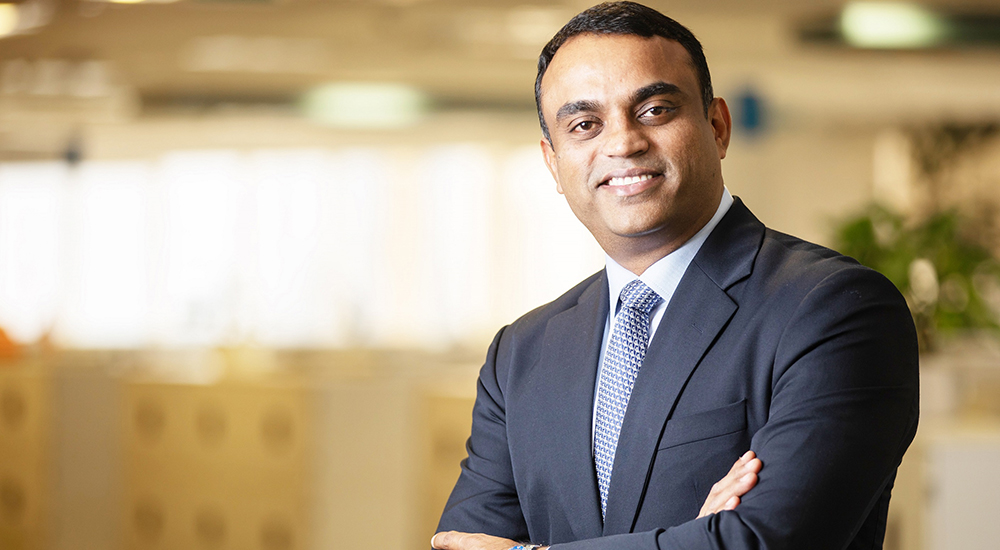How Aruba and Tech Mahindra are building transformational enterprises at the edge

Recent global surveys of IT organisations, during this period of pandemic driven changes, have two resounding messages. One, IT decision makers are accelerating their digital transformation projects, looking to keep in touch effectively with both internal and external customers. Second, never before has there been such an overwhelming external pressure on technology, in this case from the pandemic, to manage and deliver for the organisation.
Even under regular conditions of operation, that is before the pandemic, managing digital transformation for an organisation has been challenging. Not falling into a an open and shut case approach, for both the vendor and its global ecosystem of partners. For technology vendors, the traditional touch points for selling an information technology solution has always been the Chief Information Officer, CIO. But a digital transformation project, part of an organisation’s ongoing adoption journey, is not a pure play technology project.
Explains Jacob Chacko, Regional Business Head, Middle East, Saudi and South Africa at HPE Aruba. “There was a time when we used to go and talk to the CIOs. We also realised over a period of time that it was very important to speak to business owners as well. Eventually, we realised that the moment you start driving the discussion with business owners and try to show them a business outcome they can get to, the discussion actually went in a completely different direction. It was more conducive where they accepted ideas, and they were able to go along with the journey.”

CIO and CXO
As a vendor Aruba, brings across experiences from other parts of the world, showing how consumer behavior is changing, how business processes can be aligned, and how regulations are helping organisations along this journey. While CIOs have always been the first touch point, increasingly for digital transformation it is making sense to bring business into this discussion.
“More and more as we keep speaking to customers, and especially in Middle East, we are realising that is the way they would ideally want to do it. When it is driven by business, the outcomes are clearly seen,” supports Chacko.
The role of technology vendors is to build innovative solutions for organisations. Business heads on the other hand are best placed to assess the types of profitable and meaningful outcomes that can be generated from technology solutions.
Continues Chacko, “Gone are those days when networking vendors used to sell switches – everybody sells a switch today. Business has to define what are the outcomes they desire, and then try to see what technology fits into it. What technology infrastructure is actually going to help them deliver in terms of driving the business more positively? And that is the crucial differentiating factor.”
According to Ram Ramachandran, Senior Vice President and Head, Middle East and Africa, Tech Mahindra, a global system integrator that works with Aruba, one of the key success factors in the digital transformation journey, is whether an organisation is following an inside-out approach or an outside-in approach, during its adoption journey.
In the first approach, an organisation embraces digital transformation as a fixed project with defined milestones and objectives. The customer resides outside the organisation, and the project is generated from within.
Ramachandran spells out the checklist on the tips of his fingers for what he defines as an inside-out approach. “You are so concerned about your organisation that everything is concentric around it; the business case itself emerges from within the organisation; you are very concerned about cost control within this; and your customer experience seems to be okay.”

On the other hand, the outside-in approach relies on an understanding of the external environment in which the organisation exists, and the changing nature of the customer’s demands.
Ramachandran again spells out his check-list for what he defines as an outside-in approach. “How have I done the analysis of my ecosystem; how is the industry changing; is there a new way of doing a particular process; am I open to hearing multiple vendors with their ideas and thoughts; am I ready to converge upon what is best for me. All this is laid out in the beginning,” he elaborates.
So, if a CXO is continuously talking about the main objective being lowest vendor cost and also becoming digitally enabled, the chances of failure are likely to increase. “It might succeed in meeting some technical objectives set out, but is it the true digital journey that they embark on? I do not think so,” says Ramachandran.
Three pointers
Ramachandran reflects and continues, that in his opinion, there are at least three other pointers that can get flagged, and can make a difference between success and failure of a digital transformation journey. The first flag is where did the project originate from? Was it from the top and is it aligned with the leadership’s vision of the business? Does it have the right level of expectation? “It might have not been expressed in technology terms, but as long as there is clarity of vision from the top, it will succeed,” he says from experience. On the flip side, “If it is not there, it will fail,” he adds.
The second and third flags are around the technology and implementation during the digital transformation journey. Is the organisation choosing the right digital partner and the right technology? Is the organisation ready to experiment and take the first steps?
Says Ramachandran, “You can always make out. The organisations that succeed are constantly trying out new things, because digital is a lot about acceptance of failure along the journey. And not many organisations are ready for it.” However, for most organisations, digital transformation projects can get stereotyped into something like – it is a single project and I definitely need an outcome.
Continues Ramachandran, commenting from his experience in global system integration, “Wherever our engagements have been successful, the digital initiative has always been top-down led. The most successful of the use cases, and the most successful of innovative technology adoption has always stemmed from the CXO office, not necessarily from the CIOs office. Technology or digital will always be an enabler to business.”
Partner and vendor leverage
The customer experience journey is redefining digital since the fundamental look into the customer has become a part of technology. Everything else gets centered around that. The joint go to market between vendor Aruba and global systems integration partner Tech Mahindra can help correct some of the classical errors that are made early in the game.
End customers still separate the process of business value mapping and technology provisioning from each other. However, the solution lies in understanding that both processes are part of a single, complex jigsaw piece, indicates Ramachandran.
“That has been a very classic approach and whether it is the right approach or the wrong approach is debatable. But for most of the organisations that have tended to isolate them in two buckets, the outcome has not been as desired,” he stresses.
Including technology in the development of a digital strategy and identification of the right technology solution are increasingly becoming a single exercise. By jointly including vendor Aruba and global system integrator partner Tech Mahindra, early in the planning and layout of the digital transformation journey, end customers can avoid losing out. “In most cases it is not an isolated, single technology implementation project, but a system integration journey,” adds Ramachandran.
Parts of the Lego puzzle
The digital transformation journey is like a Lego puzzle, where vendor Aruba and global systems integration partner Tech Mahindra are part of the building blocks. Most organisations do not have the skill levels to complete the Lego puzzle on their own. That is why, both technology vendors and channel partners play a key role in completing the Lego puzzle.
“We are being the technology enablers and bringing the ecosystem together to ensure that things work. There are a lot of components that come in to make the journey complete. Eventually, you need ecosystem partners to come in and fill the Lego pieces. Aruba plays a role by getting all these ecosystem partners together to build the whole solution,” details Chacko.
Another part of the Lego puzzle is to understand that putting the pieces together is not a one-time exercise but is a continuous exercise. End customers need to work over a period of time to streamline their business processes to get the business outcomes they deserve.
For Aruba, therefore one of the most critical success factors is to have the right set of channel partners with domain and business expertise. “You can build fantastic solutions, but you need a strong partner ecosystem to drive that into the markets and the geographies that we work in,” reflects Chacko.
Aruba and edge transformation
As a networking technology vendor and Wi-Fi based solution company, Aruba came into existence in 2002. “Over the years, it has been quite a remarkable journey that we have undertaken. From a Wi-Fi perspective, we touch people’s lives. And when people see you are in a business which is touching people’s lives, that is where it makes an impact,” explains Chacko.
The value of the network from Aruba, is not just in connecting users and devices, but using a vast body of data in new ways for automation, insights, and personalised experiences. Aruba is innovating the edge datacentre with full-stack solutions including networking, security, compute, and storage.
With this, data created at the edge stays at the edge, driving real time automation and actionable insights. The goal is to deliver a platform for customers to innovate and build amazing experiences coupled with amazing simplicity.
For Aruba, the edge experience is a key part of delivering business value during digital transformation to its customers, and further driving the edge economy. By meeting the pain points of customers and using the edge experience, Aruba has also been able to build up multiple use case scenarios.
Tech Mahindra leading with digital
Tech Mahindra, a global systems integrator that works with Aruba, delivers connected experiences for the connected world and believes digital is about business transformation. As an organisation with revenue of $5 billion, operations in 90 countries, and 120,000+ customers, everything in Tech Mahindra is centered around digital.
“Earlier, our belief used to be to lead with domain and back it up with technology. While understanding of the business domain is still critical, in the last couple of years, we have seen it needs to be backed up with digital,” says Ramachandran.
The global systems integrator is transforming customer businesses across their products and services, business models, and business processes, leading to new revenue opportunities, enhanced customer experience, operational efficiency, reduced risk, and a better society.
“The best approach for business transformation is top-down. But in some use cases and some very technology led innovations, we probably are also going to see how a bottom-up approach for a digital journey is going to emerge. And the best would be where you can have a very nice confluence of both, top-down and bottom-up,” says Ramachandran.
Key takeaways
- For technology vendors, the traditional touch points for selling an information technology solution has always been the CIO.
- Business heads on the other hand are best placed to assess the types of profitable and meaningful outcomes that can be generated from technology solutions.
- Digital transformation has a different connotation for the various players in the game
- However, the solution lies in understanding that both processes are part of a single, complex jigsaw piece, indicates Ramachandran.
- Another part of the Lego puzzle is to understand that putting the pieces together is not a one-time exercise but is a continuous exercise.
- End customers need to work over a period of time to streamline their business processes to get the business outcomes they deserve.
- With this, data created at the edge stays at the edge, driving real time automation and actionable insights.
- The best approach for business transformation is a top-down approach.
- In some very technology led innovations, we probably are also going to see how a bottom-up approach for a digital journey is going to emerge.
- The best would be where you can have a nice confluence of both, top-down and bottom-up approach.





